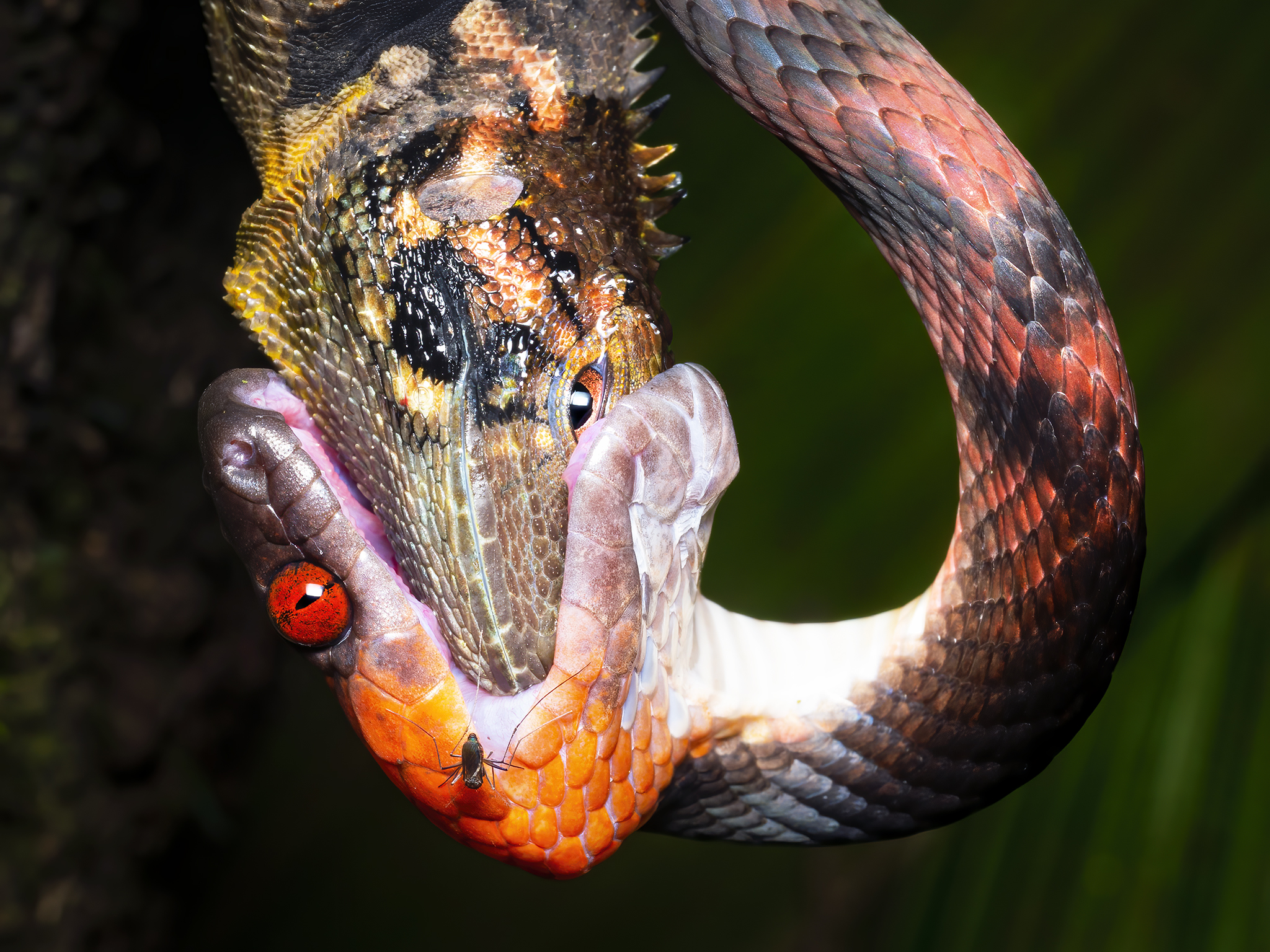A few weeks ago, I embarked on a night walk through the rainforests of Pacaya Samiria National Reserve in northeast Peru. My guide, Marcel, had decided to accompany me that evening, and we spent a few hours cutting our way through the dense jungle and seeing what creatures we could uncover.
After about an hour, we passed one of the most fascinating sites that I had ever seen in the wild. Marcel, with his thirty years of experience spotting wildlife in the park, walked straight past it, and I only just happened to catch it out of the corner of my eye.
Still an amateur at identifying deadly from docile when it comes to South American snakes, I made a wide berth before calling out ‘Serpiente!’ to Marcel. After confirming its non-venomous nature (to humans anyway), we leaned in for a closer look, only to discover it wasn’t just one reptile that we’d stumbled across…
The vibrantly coloured Tropical Flat Snake had managed to successfully snare a Blue-Lipped Tree Lizard, and was just beginning to devour it whole, despite the lizard being wider than the actual snake.
While it’s difficult to tell whether the victim is dead or simply paralysed here, this image captures the final light that will ever enter the lizard’s eyes, as a few moments later, its head was fully engulfed by the snake’s jaw.
As if all this wasn’t already showcasing nature at her brutal best, if you look closely, you’ll notice there’s even a mosquito making a meal out of the snake. I guess the old adage of ‘eat or be eaten’ doesn’t quite apply in the jungle – perhaps ‘eat and be eaten’ is a little more accurate…

Snakes will dislocate their jaws in order to be able to swallow large prey!
We all know that one. You’ve heard it from enough people. It must be true. Right?
Sorry… There’s absolutely no dislocation happening here whatsoever (except perhaps in the unfortunately lizard whose bones are being crushed). However, snakes do have a range of unique evolutionary adaptations which ensure that the reality is even more interesting!
Firstly, in a snake’s jaw, the lower half of the mandible isn’t connected at the front like it is in mammals. Instead of bone where the snake’s “chin” would be, there are stretchy ligaments that allow them to open their jaws horizontally as well as vertically, increasing the width of their mouth when consuming prey.
Furthermore, unlike our jaws which work in tandem, snake mandibles are able to move independently of each other. The upper and lower parts work separately to slowly push their unfortunate prey deeper into the snake’s throat. Simultaneously, the snake’s mouth moves forward in a side-to-side motion, literally ‘walking’ itself around the victim’s body in order to consume it.
This process often takes hours, and snakes can be at their most vulnerable when consuming prey. However, it’s also the safest time to photograph them, as you can be pretty much certain that you aren’t going to get bitten!

While all snakes have fairly similar mechanisms for swallowing their prey, they have a wide variety of tactics for actually killing their victims in the first place.
Some snakes, like vipers and elapids, rely almost entirely on their highly potent venom in order to take down prey. In extreme cases, this venom even starts the digestion process early, dissolving the internal organs of the snake’s target before it has even been eaten.
Other snakes, like boas and pythons, are non-venomous, and use powerful muscles to constrict their victim and stop the flow of oxygen. These snakes have evolved to become highly sensitive to the heartbeat of their prey, allowing them to know exactly when it’s safe to relax. Alternatively, these snakes will simply crush their victim’s ribcage, stopping the heart from beating altogether, and inducing cardiac arrest.
Finally, yet more snakes, like the Tropical Flat Snake in these photos, use a combination of mild venom and constriction in order to get the job done. These are often called ‘rear-fanged’ snakes, because if their victim happens to still be alive while it’s being swallowed, a set of backward-facing teeth ensures that escape is impossible.
South America is home to all three of these types of snake – from resourceful rear-fanged snakes, to beefy boas and venomous vipers. This diversity ensures that the life of a lizard in the Amazonian jungles is a precarious and often fleeting one, as this unfortunate Blue-Lipped Tree Lizard can surely attest.
–
Tropical Flat Snake (Siphlophis compressus) devouring a Blue-Lipped Tree Lizard (Plica umbra), Reserva Nacional Pacaya Samiria, Peru


